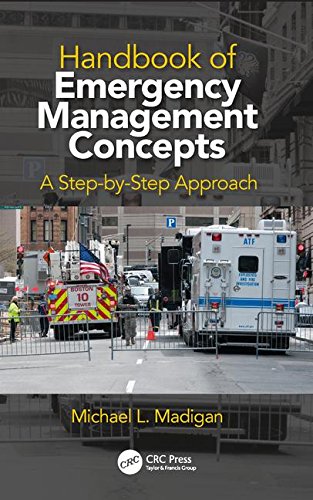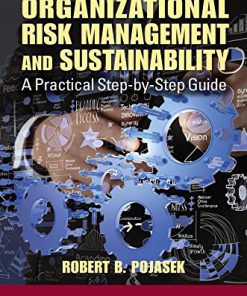Handbook of Emergency Management Concepts A Step by Step Approach 1st Edition by Michael Madigan 9781351337472 1351337475
$50.00 Original price was: $50.00.$25.00Current price is: $25.00.
Handbook of Emergency Management Concepts A Step by Step Approach 1st Edition by Michael Madigan – Ebook PDF Instant Download/Delivery: 9781351337472, 1351337475
Full dowload Handbook of Emergency Management Concepts A Step by Step Approach 1st Edition after payment

Product details:
• ISBN 10:1351337475
• ISBN 13:9781351337472
• Author:Michael Madigan
Handbook of Emergency Management Concepts
A Step-by-Step Approach
This book provides a step-by-step process that focuses on how to develop, practice, and maintain emergency plans that reflect what must be done before, during, and after a disaster, in order to protect people and property. The communities who preplan and mitigate prior to any incident will be better prepared for emergency scenarios. This book will assist those with the tools to address all phases of emergency management. It covers everything from the social and environmental processes that generate hazards, to vulnerability analysis, hazard mitigation, emergency response, and disaster recovery.
Handbook of Emergency Management Concepts A Step by Step Approach 1st Table of contents:
Chapter 1 Emergency Management
Emergency Planning Ideals
Implementation Ideals
Preincident Training and Testing
Communicating and Incident Assessment
Phases and Personal Activities
Prevention
Mitigation
Preparedness
Response
Recovery
As a Profession
Principles
Tools
Disaster Response Technologies
Within Other Professions
FEMA’s Emergency Management Institute
Chapter 2 Introduction to Emergency Management: Step by Step Process
Planning Process
Definitions
Natural Disasters
Technological Disasters
Terrorist Disasters
Emergency Manager’s Role
Local Management
Planning Process
Hazard Mitigation
Preparedness
Response
Recovery
Strategy Mix
Summary
Key Terms
The Four Pillars of Emergency Management
Mitigation
Preparedness
Response
Recovery
Hazard Vulnerability Analysis
Hazard Vulnerability Analysis Assessment
The Principles of Emergency Management
Tools Used in Emergency Management
Emergency Management Committee
Comprehensive Emergency Management Plan
Incident Command System
Review
Emergency Management Stakeholders
Stakeholders
Social Groups
Economic Groups
Government Stakeholders
Involving Stakeholders
Power
Policy Process
Agenda Setting
Policy Formulation
Policy Adoption
Summary
Key Terms
Building an Effective Emergency Management Organization
Local Emergency Management Agency
Emergency Manager
Local Emergency Management Agencies
Funding Sources
Effective Organizations
LEMA Effectiveness
Planning Process
Outcomes
Emergency Operations Plan
Summary
Key Terms
Risk Perception and Communication
Risk and Warning
Warning Processing
Continuing Hazard Phase
Strategic Analysis
Operational Analysis
Resource Mobilization
Program Development
Program Implementation
Escalating Crisis Communication
Risk Communication
Summary
Key Terms
Principal Hazards in the United States
Environmental Hazards
Meteorological Hazards
Wildfires
Floods
Storm Surge
Geophysical Hazards
Technological Hazards
Toxic Chemicals
Biological Hazards
Summary
Key Terms
Hazard and Disaster Classification
Major Categories
Earth Hazardous to Your Health
Still Hazardous
Categories of Natural Hazards
Atmospheric-Sourced Processes
Geological-Sourced Processes
Hydrological-Sourced Processes
Extraterrestrial Processes
Biological Processes
Anthropogenic Nonintentional
Technological
Nuclear
Transportation
Structural
Anthropogenic Intentional Hazards
Mass Shootings
Civil Disobedience
Terrorism
WMD CBRNE (Chemical, Biological, Radiological, Nuclear, and High-Yield Explosives)
Hazard, Vulnerability, and Risk Analysis
Community Vulnerability
Preimpact Conditions
Event-Specific Conditions
Social Impacts
Interventions
Hazard and Vulnerability Analyses
Physical Vulnerability Assessment
Social Vulnerability Assessment
Vulnerability Analysis
Assessing Risk
Summary
Key Terms
Hazard Mitigation
Hazard Mitigation
Mitigation Strategies
Land-Use Practices
Building Construction Practices
Structural Protection
Hazard Mitigation Measures
Natural Hazards
Summary
Key Terms
Disaster Myths, Disaster Demands, and Citizen Emergency Response
Response Myths
Shock and Panic
Victim Response
Integrative Responses
Warnings
Evacuation
Search and Rescue (Disaster Research Center,
Household Behavior
Stress and Health
Summary
Key Terms
Preparedness for Emergency Response and Disaster Recovery
Emergency Planning Principles
Response Functions
Organizational Structures
Incident Management System
IMS Implementation
Emergency Operations Centers
Organizational Structures
Metropolitan Medical Response System
Urban Areas Security Initiative
National Incident Management System
EOP Components
Summary
Key Terms
Organizational Emergency Response
Emergency Assessment
Hazard Monitoring
Monitoring and Assessment
Hazard Operations
Population Protection
Protective Actions
Population Protection
Care of Victims
Emergency Medical Care
Exposure Control
Incident Management
Summary
Key Terms
Disaster Recovery
Communities
Recovery Process
Household Recovery
Business Recovery
State and Federal Governments
Local Government Recovery
Recovery Operations Plan
Short-Term Recovery
Long-Term Reconstruction
Recovery Management
Summary
Key Terms
Evaluation
Performance Appraisals
Organizational Evaluation
NFPA Standard 1600
Capability Assessment for Readiness Program
Emergency Management Accreditation Program
Drill, Exercises, and Incidents
Training and Risk Communication
Summary
Key Terms
International Emergency Management
Policy Variations
Economic Resources
Government Organization
Military and Organizations
Emergency Management in Brazil (
New Zealand Restructuring
India’s Recovery
Land-Use in Colombia
Seveso Directives
Chi-Chi Earthquake
Summary
Professional Accountability
Distinguishing Emergency Management
Defining “Profession”
Emergency Management as a Profession
Development and Ethics
Body of Knowledge
Emergency Management Certification
Academic Programs
Legal Liability
Summary
Key Terms
Future Directions in Emergency Management
Global Challenges
Opportunities
National Challenges
Terrorist Threats
National Challenges
Professional Challenges
Professional Opportunities
Summary
Chapter 3 Security Management
Loss Prevention
Security Risk Management
Types of Security Threats
External
Internal
Risk Options
Risk Avoidance
Risk Reduction
Risk Spreading
Risk Transfer
Risk Acceptance
Security Policy Implementations
Intrusion Detection
Procedures
What is Security?
Perceived Security Compared to Real Security
Categorizing Security
Security Concepts
Home Security
Computer Security
Security Management in Organizations
3D Security
Security and Classified Information
Government Classification
Typical Classification Levels
Top Secret
Secret
Confidential
Restricted
Official
Unclassified
Clearance
Compartmented Information
International
NATO Classifications
United States
Classified Information in the United States
Corporate Classification
Traffic Light Protocol
Risk
Definitions
Areas
Risk Assessment and Analysis
Quantitative Analysis
Security Increase
Surveillance
A “Nest” of Surveillance Cameras
Countersurveillance, Inverse Surveillance, Sousveillance
Chapter 4 Crisis Management
Introduction
Types of Crisis
Natural Disaster
Technological Crisis
Confrontation Crisis
Crisis of Malevolence
Crisis of Organizational Misdeeds
Crisis of Skewed Management Values
Crisis of Deception
Crisis of Management Misconduct
Workplace Violence
Rumors
Crisis Leadership
Sudden Crisis
Smoldering Crisis
Signal Detection
Containment and Damage Control
Business Recovery
Learning
Crisis Communication
Models and Theories Associated with Crisis Management
Crisis Management Strategy
Crisis Management Model
Crisis Management Planning
Contingency Planning
Business Continuity Planning
Structural-Functional Systems Theory
Diffusion of Innovation Theory
Role of Apologies in Crisis Management
Crisis Leadership
Unequal Human Capital Theory
Social Media and Crisis Management
Chapter 5 Consequence Management
Software
Benefits of Consequence Management Systems
Coordinating Response
Chapter 6 Risk Management
Method
Principles of Risk Management
Process
Establishing the Context
Identification
Assessment
Composite Risk Index
Risk Options
Potential Risk Treatments
Risk Avoidance
Hazard Prevention
Risk Reduction
Risk Sharing
Risk Retention
Risk Management Plan
Implementation
Review and Evaluation of the Plan
Limitations
Hazard Analysis
Hazards and Risk
Severity Definitions—Safety Related
Likelihood of Occurrence
Chapter 7 Composite Risk Management Process
Five-Step CRM Process
Levels of Risk Management
CRM Principles
Risk Assessment Matrix
Risk Priority List
Components of Risk
Exposure
Severity
Probability
Chapter 8 Hazards (Risk)
Hazard Types
Mechanical
Physical
Hazard vs Risk
Hazard Identification
Mechanical and Physical Hazards
Biological Hazards
Chemical Hazards
Environmental Hazards
Natural Hazards
Mitigating Natural Hazards
Natural Hazard and Disaster Definitions
Risk
Smaug Model—A Basis for Prioritizing Hazard Risks
Hierarchy of Hazard Control
Components of the Hierarchy
Elimination
Substitution
Engineering Controls
Administrative Controls
Personal Protective Equipment
Chapter 9 Vulnerability
Common Applications
Research
Types of Vulnerabilities
Social Vulnerability
Cognitive Vulnerability
Military
Invulnerability
Vulnerability Assessment
Vulnerability Index
Basic Methodology
In Hazard Planning
Threats to Computers and It Systems
Definitions
Phenomenology
Owasp: Relationship between Threat Agent and Business Impact
Threats Classification
System Threat Classification
Associated Terms
Corporations
Threat Source
Threat communities
Threat Action
Threat Analysis
Threat Consequence
Threat Landscape or Environment
Threat Management
Cyber Threat Management
Threat Hunting
Chapter 10 Emergency Management and Understanding the Impact of Terrorism
Origin of the Term
Definition of Terrorism
Pejorative Use
Types of Terrorism
Motivations of Terrorists
Democracy and Domestic Terrorism
Religious Terrorism
Intimate Terrorism
Perpetrators
Nonstate Groups
State Sponsors
State Terrorism
Tactics
Responses
Databases
War on Terror
U.S. Objectives
Chapter 11 Managing Terrorism Threat/Vulnerability Assessments and Risk Analysis
Developing a Terrorism Risk Management Program
Phase I—Threat Identification and Initial Site Assessment
Phase II—Detailed Risk Assessment
Phase III—Risk Management
Step 1: Identify Threats and Pair with Assets
Step 2: Identify Asset Vulnerabilities
Step 3: Determine Risk Through Scenarios
Step 4: Identify Actions, as Necessary, That Lead to Risk Reduction
Infrastructure Facility Designed Using the Crime Prevention through Environmental Design Process
Threat/Vulnerability Assessments and Risk Analysis
Threat Assessment
Vulnerability Assessment
Risk Analysis
Upgrade Recommendations
Reevaluation of Risks
Application
Crime Prevention through Environmental Design
Design Basis Threat Tactics
Unauthorized Entry (Forced and Covert)
Insider Threats
Ballistic Threats
WMDs: Chemical, Biological, and Radiological
Cyber and Information Security Threats
Chapter 12 Mass Casualty Incident and Mass Fatality Incident
Declaration of an MCI
Agencies and Responders
Emergency Medical Services
Fire and Rescue
Public Safety
Specialized Teams
Public Services
Hospitals
Flow of an MCI
Triage
Treatment
On-Site Morgue
Definitive Care
Interim-Care Center
Mass Casualty Event
Mass Fatality Incident
Mass Fatality Definition
Response Functions
Mass Fatality Management Resources
Disaster Mortuary Operational Response Team
Organization
Identification of Remains
Incidents
Mass Fatality Management
Search and Recovery
Morgue Operations
Family Assistance Center
Fatality Management
Function 1: Determine Role for Public Health in Fatality Management
Function 2: Activate Public Health Fatality Management Operations
Function 3: Assist in the Collection and Dissemination of Antemortem Data
Function 4: Participate in Survivor Mental/Behavioral Health Services
Function 5: Participate in Fatality Processing and Storage Operations
Security at a Mass Casualty and Mass Fatality Incident
Overview
Security Requirements
Security Objectives
Information to Request for Security Planning When Selecting Sites for Incident Morgue and FAC
Overview of Physical Security Assessment
Overview of Security and Traffic Control Plan Templates
Chapter 13 Emergency Management and Weapons of Mass Destruction
Definitions of the Term
Strategic
Military
Criminal (Civilian)
Treaties Not to Use WMDs
Use, Possession, and Access
Nuclear Weapons
U.S. Politics
An Atomic-Bomb Blueprint
Media Coverage
Nuclear Terrorism
Scope
Militant Groups
Incidents Involving Nuclear Material
Chapter 14 Cyberspace and Emergency Management
Virtual Environments
Recent Definitions of Cyberspace
Cyber Threat Intelligence
Types of CTI
Benefits of Tactical Cyber Intelligence
The Challenge of Attribution
Cyber Warfare
Types of Threat
Espionage
Sabotage
Denial-of-Service Attack
Electrical Power Grid
Motivations
Military
Civil
Hacktivism
Private Sector
Cyber Spying
Details
Proactive Cyber Defense
Current Status
Proactive Preemptive Operations
National Strategy to Secure Cyberspace
Cyber-Humint
Background in Cyber-Humint
Cyber-Humint Strategy Orientation
Hackers and Cyber-Humint
The Interface Between Cyber Experts and Cyber-Humint
Cybersecurity Standards
European Telecommunications Standards Institute (ETSI) Cybersecurity Technical Committee
ISO 27001 and 27002
Standard of Good Practice
National Institute of Standards and Technology
Chapter 15 Emergency and the National Incident Management System (NIMS)
Introduction
Summary
Considerable Preparation Needed
Certified Emergency Manager
Maintaining Certification
Benefits of Certifications
Chapter 16 School Emergency Response Plan Template
Emergency Response Plan (ERP) Template
Emergency Response Plan Organization
Agency/Department–Focused ERP Format Basic Plan
Example 1 LERP for Schools
Table of Contents
I. Introduction Material
A. Promulgation Statement
Promulgation Document
B. Approval and Implementation
Approval and Implementation Page
II. Purpose, Scope, Situation, and Assumptions
A. Purpose
B. Scope
C. Situation Overview
D. Planning Assumptions
III. Concept of Operations
A. General
B. Six Key Areas of Emergency Planning and Incident Management
C. National Incident Management System (NIMS)
D. Emergency Operations Plan Activation Authority and Communication
IV. Organization and Assignment of Responsibilities
A. Organization
Policy Group (District)
School Site Safety and Security Staff
District or School Departments
B. School Position Roles and Expected Actions
Principal/Building Administrator
Teachers
Instructional Assistants
Counselors, Social Workers, and Psychologists
School Nurses/Health Assistants
Custodians/Maintenance Personnel
School Secretary/Office Staff
Food Service/Cafeteria Workers
Transportation/Bus Drivers
Other Staff (Itinerant Staff, Substitute Teachers)
Students
Parents/Guardians
V. Direction, Control, and Coordination
A. Incident Command
Incident Command System
Incident Management
Organization Expansion
Incident Command Post
Incident Commander
Unified Command
Public Information Officer
Operations Section
Planning Section
Logistics Section
Finance/Administration Section
Source and Use of Resources
B. Communication
C. Notification and Warning
D. Emergency Public Information
E. Non-Emergency External Communications
VI. Information Collection, Analysis, and Dissemination
VII. Administration, Finance, and Logistics
VIII. Plan Development and Maintenance
A. Plan Development and Maintenance
B. Testing, Training, and Exercise
C. Plan Contact Information
D. Record of Change
E. Record of Distribution
IX. Authorities and References
X. Definitions
Emergency Response Plan Template
1. Background Information
Chapter 17 State or Local Emergency Response Plan Template
Emergency Management Program
Components of the Emergency Operations Plan
Component Response Diagram
Table of Contents
I. Introduction
A. Purpose
B. Scope and Applicability
C. Situation and Planning Assumptions
D. Policies
II. Hazard Identification and Risk Assessment
III. Organizational Structure
IV. Concept of Operations
Incident Management Actions
A. Notification
B. Alert and Warning
C. Activation of the EOC/Emergency Response Team (ERT)
D. Response Actions
E. Assess Damage and Analyze Impact
F. Request for Federal Assistance under the Stafford Act
G. Recovery Actions
Short-Term Recovery
Long-Term Recovery
State Public Assistance Program—Emergency Relief to Localities
H. Mitigation Actions
V. Roles and Responsibilities
A. State Government—Governor of the State
The Governor/Director Emergency Manager: (DEM)
State Coordinator and DEM
Emergency Response Team (ERT)
State Agencies and Institutions of Higher Education
B. Local Government
C. Non-Governmental Organizations (NGOs)
D. Private Sector Partners (PSPs)
VI. Plan Management And Maintenance
A. Coordination
B. EOP Maintenance
C. Standards for other Emergency Plans
D. Plan Testing, Training, and Exercises
E. Plan Implementation
VII. Authorities and References
Chapter 18 Indian Ocean Tsunami 2004 Case Study
Indian Ocean Tsunami 2004: Impact on Landscape and Population
Landscape
People
Indian Ocean Tsunami 2004: Methods of Prediction
Indian Ocean Tsunami 2004: Role of Aid Agencies
Short-Term Aid
Long-Term Aid
Effectiveness
Impact of the 2004 Tsunami in the Islands of Indian Ocean: Lessons Learned
Introduction
Impact of the Tsunami in the Islands of the Indian Ocean
Lessons Learned from the 2004 Tsunami
National Level
Regional Level
International Level
Conclusion
Chapter 19 Gulf of Mexico Oil Spill and BP Case Study
Economic Impact
Environmental Impact
Lessons Learned From The BP Oil Spill
Improving The Safety of Offshore Operations
The Need for a New Approach to Risk Assessment and Management
Recommendations
Strengthening Oil Spill Response, Planning, and Capacity
Recommendations
The Need for a New Approach to Handling Spills of National Significance
Recommendations
The Need to Strengthen State and Local Involvement
Local Involvement in Oil Spill Drills
Volunteer Management Program
Vessel of Opportunity Program
Appendix A: Terms and Definitions
Appendix B: Acronyms and Abbreviations
Emergency Support Functions and Emergency Management Planning
References
Index
Read Less
People also search for Handbook of Emergency Management Concepts A Step by Step Approach 1st:
handbook of emergency management concepts
fundamentals of emergency management pdf
emergency management concepts and strategies for effective programs
concepts of emergency management
emergency handbook
You may also like…
Education Studies & Teaching - School Education & Teaching
Writing the winning thesis or dissertation a step by step guide Fourth Edition Randy L. Joyner
Medicine - Clinical Medicine
Arts - Graphic Arts
Politics & Philosophy - Social Sciences
Developing Helping Skills: A Step-By-Step Approach to Competency 3rd Edition Valerie Nash Chang











